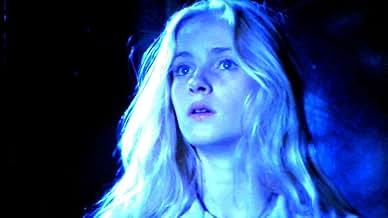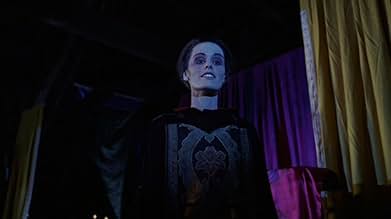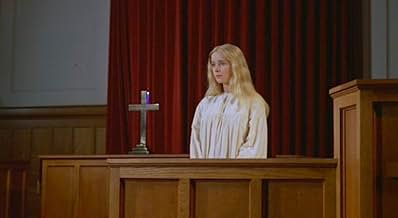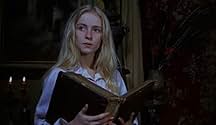PUNTUACIÓN EN IMDb
6,1/10
2,6 mil
TU PUNTUACIÓN
Añade un argumento en tu idiomaA young girl who returns to her hometown to see her dying father finds herself being drawn into a web of vampirism and witchcraft.A young girl who returns to her hometown to see her dying father finds herself being drawn into a web of vampirism and witchcraft.A young girl who returns to her hometown to see her dying father finds herself being drawn into a web of vampirism and witchcraft.
Argumento
¿Sabías que...?
- CuriosidadesNotably similar to the story Carmilla by Sheridan Le Fanu in which a female seduces a teenage girl. Towards the end of the film Lemora indicates that she has had many names.
- PifiasWhen Lila is first taken into the house by Lemora, she is told to go upstairs to her room. Lemora says "It is the first open door at the end of the hall." But when Lila goes upstairs ALL of the doors are closed.
- ConexionesFeatured in Movie Macabre: Lemora A Child's Tale of the Supernatural (1983)
- Banda sonoraPaper Angel
Sung by The Black Whole
Reseña destacada
I first read about this obscure 70s vampire flick a couple of years back, in one of my numerous reference books on hard-to-find films. Having never heard of director Richard Blackburn at the time and being a fan of the more exotic and offbeat in cinema (not to mention that I was extremely keen on seeing the film), I decided to try to locate it on VHS. Unfortunately this would turn out to be an almost impossible task (as with most films of this kind), and I soon grew disillusioned and frustrated, recognizing the sad fact that I would probably never even get to see the film. Luckily this would soon change: A few weeks back I was lucky enough to come across a rare Greek pre-record/ex rental tape of the film, and, not hesitating for a moment, I bought it. Needless to say, this was a decision I have NEVER regretted since!!
The reasons for this are simple: "Lemora" (aka: Lemora-Lady vampire, The legendary curse of Lemora) is doubtless one of the best horror films I´ve seen in years, a classic that deserves to be right up there with "Night of the living dead", "The exorcist" and "Evil dead". First time director Richard Blackburn creates a chilling and highly original supernatural tale of religious anxiety, repressed sexuality and initiation, a debut film that leaves a lasting impression on both the hearts and minds of anyone lucky enough to see it.
Plotwise, the film follows a young Christian girl (Lila Lee, portrayed by Cheryl Smith), the daughter of a wanted gangster, who leaves her home town to visit her father on the death bed. As it turns out this is all a set up, and Lila soon finds herself under the spell of a female vampire called Lemora. She is the leader of some sort of religious cult in a small village deep into the woods and she plans to initiate the young girl in the cult´s activities. The young girl, sensing that something is wrong, flees from Lemora´s grasp and tries to find a way out of the labyrinthine woods. But will she make it?
Overall this is a beautiful, poetic and hauntingly surreal adult fairy tale, the horror film equivalent of "Little Red Riding Hood" (though with some modifications). Although shot on a very low budget, the film manages to overcome all its budgetary constraints and deliver a final product with more (emotional) impact than a dozen modern horror films combined. The film is genuinely creepy and atmospheric, with an almost Gothic flavour reminiscent of Hammer and Benjamin Clark & Alan Ormsby´s "Children shouldn´t play with dead things". The performances are all excellent, and the make-up & gore effects are surprisingly good, adding to the creepiness of the story. Add to all this a charismatic lead (Lemora, convincingly played by Lesley Gilb) and you have all the characteristics of a cult classic; A unique, mesmerizing film experience full of "primitive" energy, a film where you find yourself drawn into a mysterious world, yet where you can´t really describe why the film appeals to you.
What most viewers have either failed to recognize or not bothered to comment on though, is the fact that there is so much more to this film than meets the eye. Underneath the surface this intelligent & well written little low budget gem is a complex allegory (or parable if you will) concerned with questions of faith, the process of growing up and the duality of man. The whole film is one long symbolic journey, an odyssey, into the darkness of man´s heart; A journey from childhood to adolescence (leaving the childhood illusions and facing the real world), from oppression and self-deception to freedom and self-recognition. The main character leaves her safe, protected & idyllic sanctuary (church/local community), and stumbles into a frightening and nightmarish world of violence, darkness, death and lust. One the way she encounters numerous dangers and temptations (she succumbs to many of them), and she gradually changes from a young, innocent beauty with little knowledge of the world, to a mature woman who has both seen and felt death. Throughout the journey her believes are questioned, and one by one her pietistic fears are taken form her, as she finally recognizes her true nature (from which there is no escape). The characters, as well as the setting, all have a symbolic function and significance; The young, pristine girl (symbolically dressed in white; Innocence), the vile, savage, beast-like creatures out in the woods (man´s uncontrollable primal urges, sexuality, the beast in man), and Lemora (forbidden knowledge, freedom, breaking free of chains, immortality). Yes, Lemora probably symbolizes everything we do not want to face, the darkness deep inside of us.
As for themes, the film is concerned with religious hypocrisy, the breaking of taboos (sexual and others), good vs. evil, light vs. darkness, sin, and most importantly of all, recognizing the darkness within ourselves (an aspect of man that Christianity refuses to accept and for centuries has tried to suppress). The film does not draw any conclusions though, and the ending, which is both ambivalent and a bit confusing, leaves one to ponder. Did it all just happen in the young girl´s mind, and is this a film that criticizes religion as narrow-minded and suppressive or that embraces it? Personally I feel it´s the former, but some of you may disagree.
Anyway, this film comes highly recommended!! Any serious horror fan should seek out this classic at once (you´ll probably have a hard time locating it though!) And if you ask me: It´s definitely about time that this horror masterpiece gets a DVD release (Anchor Bay, please read this!!).
The reasons for this are simple: "Lemora" (aka: Lemora-Lady vampire, The legendary curse of Lemora) is doubtless one of the best horror films I´ve seen in years, a classic that deserves to be right up there with "Night of the living dead", "The exorcist" and "Evil dead". First time director Richard Blackburn creates a chilling and highly original supernatural tale of religious anxiety, repressed sexuality and initiation, a debut film that leaves a lasting impression on both the hearts and minds of anyone lucky enough to see it.
Plotwise, the film follows a young Christian girl (Lila Lee, portrayed by Cheryl Smith), the daughter of a wanted gangster, who leaves her home town to visit her father on the death bed. As it turns out this is all a set up, and Lila soon finds herself under the spell of a female vampire called Lemora. She is the leader of some sort of religious cult in a small village deep into the woods and she plans to initiate the young girl in the cult´s activities. The young girl, sensing that something is wrong, flees from Lemora´s grasp and tries to find a way out of the labyrinthine woods. But will she make it?
Overall this is a beautiful, poetic and hauntingly surreal adult fairy tale, the horror film equivalent of "Little Red Riding Hood" (though with some modifications). Although shot on a very low budget, the film manages to overcome all its budgetary constraints and deliver a final product with more (emotional) impact than a dozen modern horror films combined. The film is genuinely creepy and atmospheric, with an almost Gothic flavour reminiscent of Hammer and Benjamin Clark & Alan Ormsby´s "Children shouldn´t play with dead things". The performances are all excellent, and the make-up & gore effects are surprisingly good, adding to the creepiness of the story. Add to all this a charismatic lead (Lemora, convincingly played by Lesley Gilb) and you have all the characteristics of a cult classic; A unique, mesmerizing film experience full of "primitive" energy, a film where you find yourself drawn into a mysterious world, yet where you can´t really describe why the film appeals to you.
What most viewers have either failed to recognize or not bothered to comment on though, is the fact that there is so much more to this film than meets the eye. Underneath the surface this intelligent & well written little low budget gem is a complex allegory (or parable if you will) concerned with questions of faith, the process of growing up and the duality of man. The whole film is one long symbolic journey, an odyssey, into the darkness of man´s heart; A journey from childhood to adolescence (leaving the childhood illusions and facing the real world), from oppression and self-deception to freedom and self-recognition. The main character leaves her safe, protected & idyllic sanctuary (church/local community), and stumbles into a frightening and nightmarish world of violence, darkness, death and lust. One the way she encounters numerous dangers and temptations (she succumbs to many of them), and she gradually changes from a young, innocent beauty with little knowledge of the world, to a mature woman who has both seen and felt death. Throughout the journey her believes are questioned, and one by one her pietistic fears are taken form her, as she finally recognizes her true nature (from which there is no escape). The characters, as well as the setting, all have a symbolic function and significance; The young, pristine girl (symbolically dressed in white; Innocence), the vile, savage, beast-like creatures out in the woods (man´s uncontrollable primal urges, sexuality, the beast in man), and Lemora (forbidden knowledge, freedom, breaking free of chains, immortality). Yes, Lemora probably symbolizes everything we do not want to face, the darkness deep inside of us.
As for themes, the film is concerned with religious hypocrisy, the breaking of taboos (sexual and others), good vs. evil, light vs. darkness, sin, and most importantly of all, recognizing the darkness within ourselves (an aspect of man that Christianity refuses to accept and for centuries has tried to suppress). The film does not draw any conclusions though, and the ending, which is both ambivalent and a bit confusing, leaves one to ponder. Did it all just happen in the young girl´s mind, and is this a film that criticizes religion as narrow-minded and suppressive or that embraces it? Personally I feel it´s the former, but some of you may disagree.
Anyway, this film comes highly recommended!! Any serious horror fan should seek out this classic at once (you´ll probably have a hard time locating it though!) And if you ask me: It´s definitely about time that this horror masterpiece gets a DVD release (Anchor Bay, please read this!!).
- norfaust
- 13 dic 2000
- Enlace permanente
Selecciones populares
Inicia sesión para calificar y añadir a tu lista para recibir recomendaciones personalizadas
- How long is Lemora: A Child's Tale of the Supernatural?Con tecnología de Alexa
Detalles
- Fecha de lanzamiento
- País de origen
- Idioma
- Títulos en diferentes países
- Lemora: A Child's Tale of the Supernatural
- Localizaciones del rodaje
- Phillips Mansion - 2640 W. Pomona Boulevard, Pomona, California, Estados Unidos(Lemora's house exteriors)
- Empresa productora
- Ver más compañías en los créditos en IMDbPro
Contribuir a esta página
Sugerir un cambio o añadir el contenido que falta

Principal laguna de datos
By what name was Lemora (1973) officially released in India in English?
Responde




















